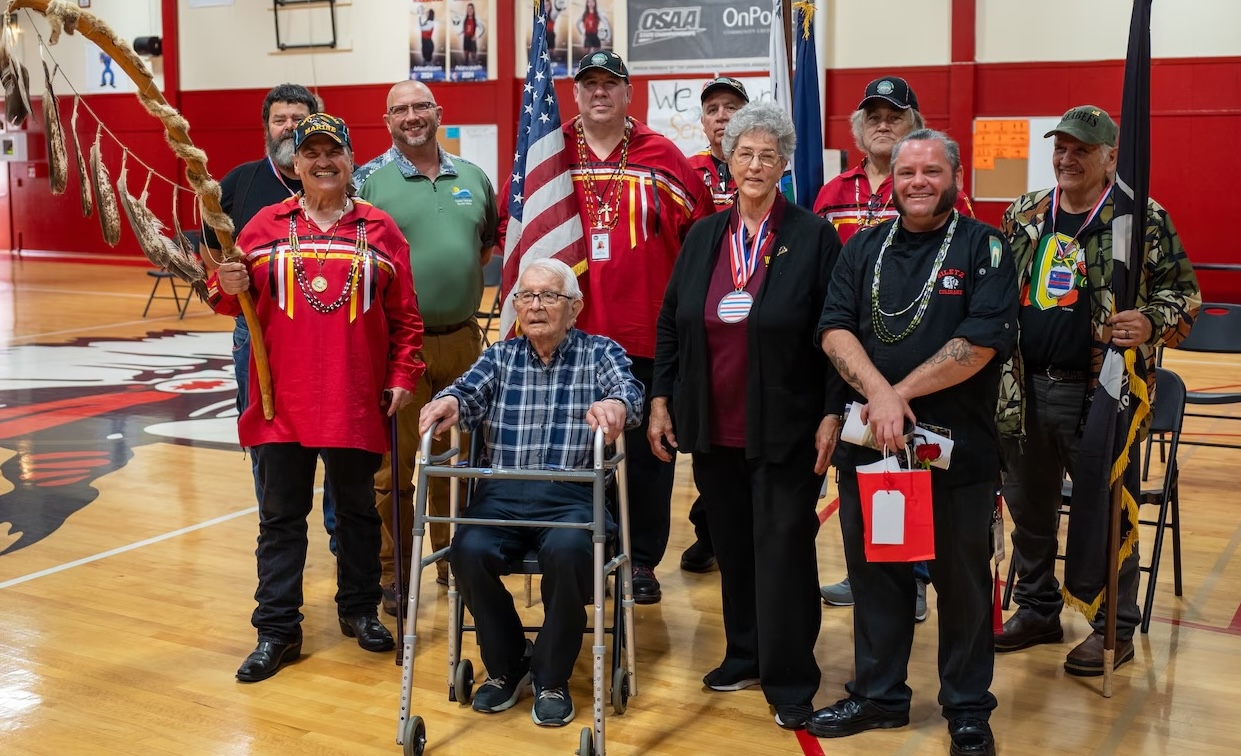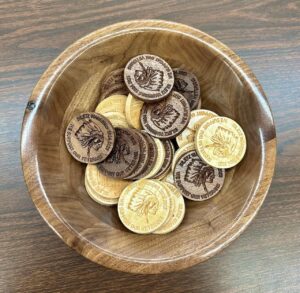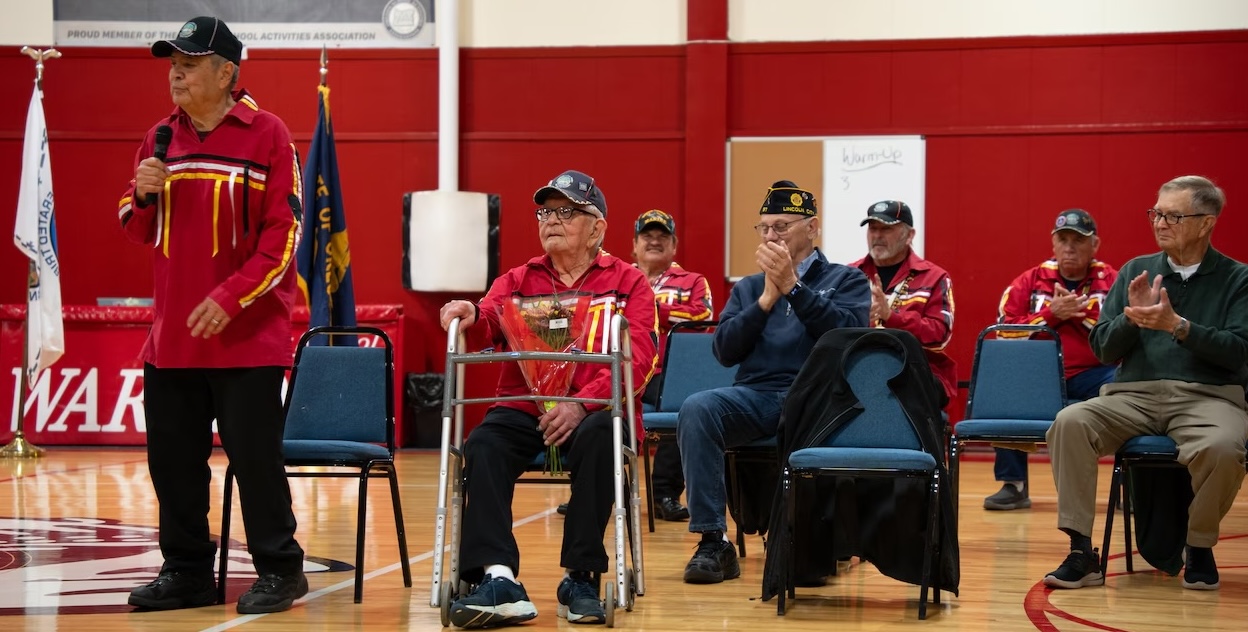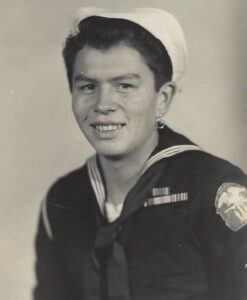
By LORI TOBIAS/The Oregonian/OregonLive
It all started at the Siletz Valley School in 1985 as a simple way to say thank you to Lincoln County veterans. On that day, about a dozen veterans showed up for a school assembly.
Before long the November gathering became an annual tradition, attracting as many as 100 veterans at its height. Nearly four decades later, it remains an honored tradition that sees the whole community involved, from U.S. flags flying downtown to breakfast at the Siletz Grange and a reception at the school capping the day.
Tony Molina, who served in the U.S. Army Signal Corps and as a veteran representative for the Confederated Tribes of Siletz Indians, has played a role from the start.
“A couple of teachers knew I was a Vietnam veteran, and they just figured I knew quite a few veterans and if I could get them to the school, the school could do a program and pay tribute,” he said.
Last Thursday, the school continued the tradition, now in its 39th year.

Patrick Clarke, who is the school’s culinary director, spoke about his experiences as a cook in the U.S. Army and how those skills lead him to where he is today. As always, students presented the veterans, numbering about a dozen, with handcrafted gifts including wooden challenge coins, keychains, handkerchiefs and medallions.
Over the years, students have put on skits, written poems, hung banners and painted pictures. They carried signs reading “We Love Our Veterans,” and read letters of appreciation. There was a drumming ceremony and PowWow dance as well as a presentation by the Siletz Honor Guard.
The Confederated Tribes of Siletz Indians has a proud tradition of service, Molina said.
During the Vietnam era, 90 percent of the tribe’s eligible members volunteered for duty, he noted. Although the number of Siletz tribal members serving today is lower, Native Americans serve in the U.S. Armed Forces at five times the national average and at higher rates per capita than any other minority group, according to to the Oregon Department of Veterans’ Affairs.
The reason is simple, Molina said. “Just love for the country. I enlisted in the U.S. Army; so did my dad and all of my uncles. It was just sort of handed over to our age group. It is quite an honor.”

Ceremony can be emotional
In the early years of the school’s assembly, Molina recalls working hard to reach World War II veterans. One of those was Edmond Ben, 96, the last living WWII veteran member of the Confederated Tribes of Siletz Indians. Ben, who at age 17 enlisted in the U.S. Navy three months before the war ended, has taken part in nearly every assembly.

“The Siletz Honor Guard carries the flags in; the young teenagers drum our Native songs for the veterans to come in from the outside and post the flags,” Ben said in an interview. “The entire school shows up and gets in the stands and the kids make gifts. There was one first grade class that always made dentalium shell necklaces for the veterans. I’m sitting here in my living room, and I see several on the walls.”
For many of the WWII veterans, it is an emotional afternoon, Molina said.
“In the beginning, many, many years ago when there were smaller groups, we would go to certain classrooms and let the students ask any questions they wanted to,” Molina said. “It was pretty moving. They all had tears in their eyes. One WWII veteran was so moved, he grabbed the mic and spoke to the students and said how much he appreciated them.”
While the main event of the day is the school assembly, the celebration begins in the morning when Siletz VFW Auxiliary member Debby Fawver raises the flags downtown and the Siletz Grange welcomes veterans with coffee and pastries. Lunch is served at the school, followed by the assembly. The day ends with a cake social to allow veterans the space and opportunity to spend time together, said Debra Barnes, director of academic programs at the Siletz Valley School.
“Events like this are important, not only to the veteran, but for the students,” said Keith Barnes, Lincoln County’s Veteran Services officer. “They get a chance to learn about what great individuals we have in our community, to connect with those around them and to experience both giving and receiving, gratitude. It’s always a good assembly and always good to honor and have a chance for youth to say thank you and recognize the sacrifice our service members have made.”
Much of the Veterans Day event has remained true to tradition over the years, but some things have changed. Students no longer shake hands with each veteran – Covid brought an end to that. And the numbers of veterans attending are a fraction of what they were a decade ago. But the honor and respect, the appreciation, remain the same.
“Each year, it seems there are fewer and fewer veterans showing up,” said Keith Barnes. “As veterans are aging, they have less of an ability to get out and take part in these events. It is always heart-warming when you see two veterans who didn’t know each other connect and realize they are not alone in the community.”
- This story appeared Friday, Nov. 8, 2024 in The Oregonian/OregonLive and is used with permission.




I am touched and honored that the members of the Confederated Tribes of Siletz and members of many other tribes treat this country in a much better way than it has treated them. I served for 20 years and I’m proud to have served along side tribal members. Thank you for your service.